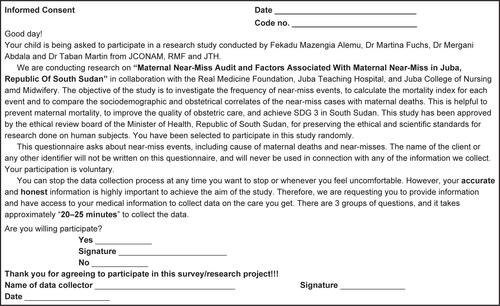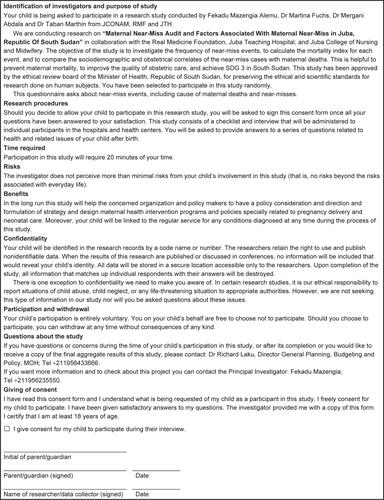Abstract
Background
This study investigates the frequency of near-miss events and compares correlates in the world’s newest nation.
Methods
A cross-sectional study was carried out to audit near-miss events and their causes. A total of 1,041 mothers were sampled. Data were gathered using World Health Organization near-miss evaluation tools according to morbidity and organ failure-based criteria. Intensive care unit admission criteria were not used (as there is no functional intensive care unit in Juba Teaching Hospital). Descriptive statistics and bivariate and multivariable logistic regression were used to analyze the data. The study adhered to the Declaration of Helsinki.
Results
Nearly half (49.7%) of the clients were young pregnant women (aged 15–24 years), with a mean age of 25.07±5.65 years. During the study period, there were 994 deliveries, 94 near-misses, and 10 maternal deaths. This resulted in maternal near-miss and mortality rates of 94.1 per 1,000 and 1,007 per 100,000 live births, respectively. Severe maternal outcome and maternal near-miss rates were 10.47 per 1,000 (morbidity-based criteria) and 41.3 per 1,000 (organ failure-based criteria), respectively. The likelihood of mortality was 25% (95% CI 10%–51%) for a ruptured uterus, 9% (95% CI 4%–17%) for severe postpartum hemorrhage, and 11% (95% CI 3%–30%) for eclampsia. Anemia, hemorrhage, and dystocia were the highest contributory factors in the occurrence of maternal near-misses.
Conclusion
The near-miss rate was high. Contributing factors were lack of resources, low quality of primary health care, and delays in care. All near-misses should be regarded as opportunities to improve the quality of maternity care. Health institutes should address delays in conducting interventions, referral barriers, and personnel gaps. Fully functional intensive-care units must be created in all facilities, including Juba Teaching Hospital and other hospitals. Notification policies for all near-miss cases should be in place in all health care units, with a “no shame, no blame” approach.
Supplementary materials
Acknowledgments
We acknowledge all participants in the study, who gave us their precious time and honest answers. We are grateful to all data collectors and supervisors. The Ministry of Health, Republic of South Sudan, the Directorate of Research and Planning, Juba Teaching Hospital, and Juba College of Nursing and Midwifery are also greatly acknowledged. This research was funded by the Real Medicine Foundation, South Sudan Country Office.
Author contributions
All authors contributed toward data analysis, drafting and critically revising the paper, gave final approval of the version to be published, and agree to be accountable for all aspects of the work.
Disclosure
The authors report no conflicts of interest in this work.


